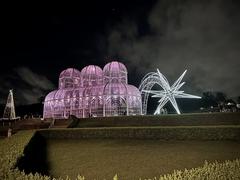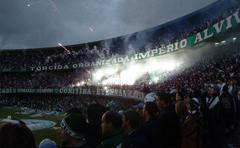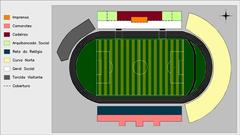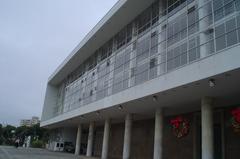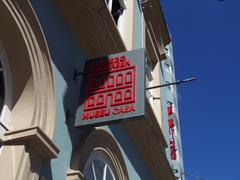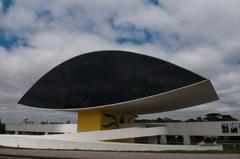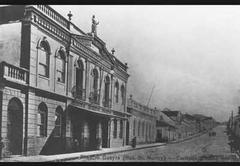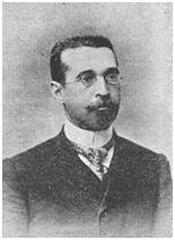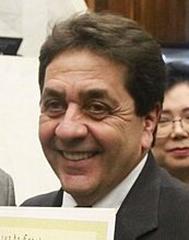Museu Paranaense: Visiting Hours, Tickets, and Historical Sites in Curitiba
Date: 04/07/2025
Introduction
Nestled in the historic heart of Curitiba, Brazil, the Museu Paranaense (MUPA) stands as a beacon of cultural preservation and scientific inquiry. Established on September 25, 1876, it is the third oldest museum in Brazil and the first scientific institution in Paraná, originally conceived by Judge Agostinho Ermelino de Leão and physician José Cândido da Silva Murici to showcase the province’s diverse wealth (Museu Paranaense official site). Over almost 150 years, the museum has grown from a modest 600-item collection to a vast repository of between 400,000 and 800,000 artifacts, making it one of Latin America’s most significant cultural institutions (Bem Paraná).
Located since 2002 in the architecturally impressive Palácio São Francisco—a blend of Neoclassical and Modernist styles with Germanic influences—the museum provides both a compelling exhibition space and a historical setting that enhances the visitor experience (Curitiba e Paraná em Fotos Antigas). The collections span indigenous artifacts, archaeological and anthropological materials, historical documents, numismatic treasures, and fine arts, all reflecting the multifaceted identity of Paraná shaped by indigenous peoples, immigrants, and urban transformation.
The museum is open Tuesday through Sunday, 10:00 AM to 5:00 PM, with free admission and full accessibility accommodations, including wheelchair access and support for those with disabilities. Guided tours in Portuguese are regularly available, with occasional English-language options (Museu Paranaense official site). The museum also actively engages with contemporary issues through special events, workshops, and collaborations with indigenous communities and academic institutions (SpringerOpen).
This guide provides essential information about visiting hours, ticketing, accessibility, key exhibitions, and nearby historical sites, ensuring a rewarding experience for anyone interested in Paraná’s past and present (Curitiba Insider).
Table of Contents
- Founding and Early Years (1876–1882)
- Transition to Public Institution and Growth (1882–Early 20th Century)
- Multiple Relocations and Architectural Evolution
- Expansion of Collections and Scientific Contributions
- Modernization and Cultural Impact
- Visiting Museu Paranaense: Practical Information
- Guided Tours, Special Events, and Highlights
- Permanent and Signature Exhibitions
- Visitor Experience and Facilities
- Nearby Curitiba Historical Sites
- Frequently Asked Questions (FAQs)
- Conclusion and Call to Action
Founding and Early Years (1876–1882)
The Museu Paranaense was established as Brazil’s third oldest museum and Paraná’s first scientific institution, driven by the vision of Agostinho Ermelino de Leão and José Cândido da Silva Murici. Its original home was a room in the former State Treasury at Praça Zacarias, central Curitiba (Bem Paraná). Inaugurated with around 600 items, including indigenous artifacts, coins, minerals, and natural specimens, the museum’s early collection mirrored its founders’ intent to represent the region’s biodiversity and cultural heritage (Visite Curitiba).
Transition to Public Institution and Growth (1882–Early 20th Century)
In 1882, the Museu Paranaense transitioned from a private initiative to a state institution, which led to continuous donations and acquisitions that expanded its collection and scope (Museu Paranaense official site). Under the guidance of prominent directors like Romário Martins and Loureiro Fernandes, the museum became a center for scientific research and cultural documentation, supporting the study of archaeology, anthropology, and local history (Bem Paraná).
Multiple Relocations and Architectural Evolution
Throughout its history, the museum has occupied six different sites, reflecting both its growing collection and evolving mission. Since 2002, it has been housed in the Palácio São Francisco, a palace built in 1928–1929 by German entrepreneur Júlio Garmatter. The building’s Neoclassical and Modernist architecture, combined with Germanic details, make it an architectural gem in Curitiba (Curitiba e Paraná em Fotos Antigas). Before its current role, the palace served as a government seat and as the Museu de Arte do Paraná. The building now includes modern facilities such as laboratories, a library, an auditorium, and spaces for both permanent and temporary exhibitions.
Expansion of Collections and Scientific Contributions
Today, the Museu Paranaense holds between 400,000 and 800,000 items, making it one of the most significant collections in Brazil and Latin America (Museu Paranaense official site; Bem Paraná). The collection includes:
- Indigenous artifacts, notably from the Vladimir Kozák collection (Tiplr)
- Historical documents, maps, and photographs
- Coins, medals, and numismatic items
- Paintings, sculptures, and period furniture
- Archaeological materials: lithic, ceramic, and biological
- Anthropological collections: basketry, featherwork, weapons, adornments, and ceramics
- Natural history specimens: insects, birds, minerals
The museum has played a pivotal role in documenting Paraná’s archaeological and anthropological heritage, supporting research and publishing findings that enhance understanding of Brazil’s regional history (Museu Paranaense official site).
Modernization and Cultural Impact
The move to Palácio São Francisco ushered in a period of modernization, allowing the museum to host large-scale exhibitions, educational activities, and community events (Curitiba e Paraná em Fotos Antigas). The museum’s programming engages with contemporary themes, fosters cultural diversity, and promotes dialogue around social inclusion (SpringerOpen). Its collaborations with indigenous and immigrant communities, as well as universities and artists, have made it a reference point for participatory and socially engaged museology.
Visiting Museu Paranaense: Practical Information
- Address: Palácio São Francisco, Rua Kellers, 289, São Francisco, Curitiba, PR, Brazil
- Visiting Hours: Tuesday to Sunday, 10:00 AM to 5:00 PM (some sources note closing at 5:30 PM); closed Mondays and some public holidays (Museu Paranaense official site)
- Admission: Free for all visitors (parana.pr.gov.br)
- Accessibility: Wheelchair accessible; facilities for visitors with disabilities (ramps, elevators, accessible restrooms)
- Travel Tips: Centrally located, easily reached by public transit, foot, or taxi. Bike racks and nearby parking are available, but public transportation is recommended during busy periods.
Guided Tours, Special Events, and Highlights
- Guided Tours: Available in Portuguese, with occasional English-language options. Advance booking is advised, especially for groups.
- Special Events: Regular programming includes workshops, lectures, performances, and temporary exhibitions.
- Photographic Opportunities: The palace’s interiors, gardens, and exhibitions provide excellent settings for photography.
Permanent and Signature Exhibitions
Archaeological and Ethnographic Collections
The museum’s archaeological collection, one of Brazil’s largest, features tools, ceramics, and funerary urns from prehistoric Paraná (travel.com.br). The ethnographic collections highlight indigenous groups like the Guarani, Kaingang, and Xetá, and document the cultural diversity introduced by waves of immigrants (whichmuseum.co.uk).
Historical Documents and Art
Extensive archives include rare manuscripts, maps, photographs, and a significant numismatic collection. Decorative arts, period furniture, and paintings provide a glimpse into the lifestyles of Paraná’s elite during the 18th and 19th centuries.
“Vastas Memórias” (Vast Memories)
This thematic exhibition explores Paraná’s identity through indigenous heritage, migration, and social movements, using artifacts, multimedia, and personal testimonies (travel.com.br).
Pavilhão de Ocupação do Território Paranaense
A chronological display tracing the region’s history from prehistory to the present, covering indigenous societies, Jesuit missions, immigration, and significant socio-political events (whichmuseum.co.uk).
Temporary Exhibitions
Rotating exhibitions address contemporary issues, local artists, and social themes, ensuring relevance and ongoing engagement (whichmuseum.co.uk).
Visitor Experience and Facilities
- Building and Gardens: The São Francisco Palace offers historic ambiance, landscaped gardens, and peaceful outdoor seating (33Travels).
- Amenities: Restrooms, water fountains, ramps, elevators, and a small café/snack area (may vary during renovations).
- Accessibility: Facilities for visitors with disabilities, tactile exhibits, and signage in Portuguese and English.
- Photography: Non-flash photography is typically permitted except in restricted areas (museuparanaense.pr.gov.br).
Nearby Curitiba Historical Sites
- Praça Tiradentes: Historic city center with the Cathedral of Curitiba.
- Oscar Niemeyer Museum: Contemporary art and modern architecture (Adventure Backpack).
- Rua XV de Novembro: Lively pedestrian avenue with shops and artisan fairs.
- Largo da Ordem: Vibrant square near the museum with colonial buildings and cultural activities.
Visiting the Museu Paranaense serves as a perfect starting point to explore these sites and experience the broader cultural landscape of Curitiba.
Frequently Asked Questions (FAQs)
Q: What are the museum’s opening hours?
A: Tuesday to Sunday, 10:00 AM to 5:00 PM (occasionally until 5:30 PM); closed Mondays and select public holidays.
Q: Is admission free?
A: Yes, general admission is free. Special exhibitions may require a ticket.
Q: Are guided tours available?
A: Yes, in Portuguese, with some English-language options. Advance booking is recommended.
Q: Is the museum accessible for people with disabilities?
A: Yes, with ramps, elevators, and accessible restrooms.
Q: Can I take photographs inside?
A: Non-flash photography is generally allowed; follow posted restrictions.
Conclusion and Call to Action
The Museu Paranaense offers a multidimensional cultural experience, showcasing the diverse narratives and histories of Paraná and southern Brazil. Its inclusive approach—evident in collaborative curatorship with indigenous communities and programs addressing social inclusion—makes it a leader in modern museology (SpringerOpen). With free admission, central location, and a rich calendar of exhibitions and events, it is a must-visit destination for locals and travelers alike (Curitiba Insider).
For a deeper exploration, plan your visit by checking the latest updates on the Museu Paranaense official site, and consider using the Audiala app for audio guides and real-time information. Combine your museum visit with a tour of Curitiba’s other historical sites for a complete cultural immersion.
References
- Museu Paranaense official site, 2025 (Museu Paranaense official site)
- Bem Paraná, 2025 (Bem Paraná)
- Curitiba e Paraná em Fotos Antigas, 2025 (Curitiba e Paraná em Fotos Antigas)
- SpringerOpen, 2024 (SpringerOpen)
- Curitiba Insider, 2024 (Curitiba Insider)
- WhichMuseum, 2024 (WhichMuseum)
- Tiplr (Tiplr)
- Visite Curitiba (Visite Curitiba)
- travel.com.br (travel.com.br)
- 33Travels (33Travels)
- Adventure Backpack (Adventure Backpack)
- parana.pr.gov.br (parana.pr.gov.br)
- museuparanaense.pr.gov.br (museuparanaense.pr.gov.br)
- trek.zone (trek.zone)
- Arte Brasileiros (Arte Brasileiros)
- ICOMS Open Archive (ICOMS Open Archive)

